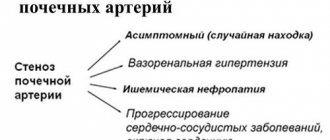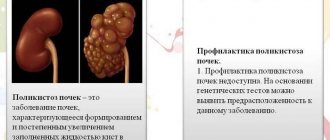Diseases of the urinary system can occur in people of different age groups. According to statistics, they are most often diagnosed in women of reproductive age, elderly men, and people suffering from alcoholism. A wrinkled kidney is no exception, which, due to drying out and decreasing in size, reduces its functionality and loses the ability to produce urine and filter it. The danger of the condition lies in the progression of the pathology and the onset of the terminal stage, when the preservation of a person’s life depends on the transplantation of a donor organ.
Kidney shrinkage: what is the danger of the disorder?
Kidney nephrosclerosis is a pathological change in a paired organ caused by the death of parenchyma cells and their replacement with fibrous fibers. The latter do not carry a functional load, but only play the role of a neutral filler. As a result, compaction and reduction in the size of the kidney occurs. Against the background of the organ’s inability to perform its functions, renal failure develops.
Quite often, this condition is considered as a consequence of other severe diseases (diabetes mellitus, hydronephrosis, arterial hypertension), although in ICD-10 it has a separate code N26.
It is important to know! The shriveled kidney was first described in 1914 by the German pathologist K. T. Fahr and clinician F. Volhard.
Types of disease
Kidney shrinkage is a process whose occurrence is caused by vascular pathologies, urological disorders, and infectious-inflammatory diseases. According to the classification, nephrosclerosis has two types.
A primarily shriveled kidney is angiogenic nephrosclerosis, which develops as a result of a disruption in the functioning of blood vessels - narrowing of their lumen, which leads to ischemia of the organ, the appearance of scars, and a heart attack. There are several types of this pathology:
- Atherosclerotic, developing due to the formation of plaques on the walls of blood vessels.
- Involutive, caused by thickening of the walls of blood vessels due to calcium deposits on them. Occurs against the background of age-related changes.
- Hypertensive nephrosclerosis caused by vascular spasms, narrowing of the lumen and ischemia.
The latter, depending on the nature of the flow, is divided into two subspecies.
- Arteriolosclerotic. It is of benign nature. Connective tissue grows on the inner walls of blood vessels, which leads to narrowing of the lumen and loss of elasticity.
- Arteriolonecrotic. It is malignant in nature. With arteriolonephrosclerosis, the death of glomeruli and small vessels occurs, accompanied by hemorrhage into the renal tubules, disruption of protein metabolism and other pathogenic changes.
Secondary wrinkled kidney - develops as a complication against the background of inflammatory or infectious processes occurring in the body, dystrophic changes in the renal apparatus - tubules, glomeruli or stroma.
Causes of nephrosclerosis
In each specific case, the influencing factors may differ, but all doctors are unanimous in determining the general grounds. The list of causes of the formation of primary nephrosclerosis includes the following conditions.
- Atherosclerosis. The narrowing of blood vessels occurs due to the deposition of fatty plaques and cholesterol formations on their walls. Blood supply deteriorates, and organ cells die from oxygen starvation.
- Kidney infarction. Blocking the lumen of a vessel with a thrombus or embolus leads to disruption of blood flow and death of part of the organ.
- Venous congestion. Violation of the outflow of venous blood due to narrowing of the lumen creates conditions for the growth of collagen in the wall of blood vessels and loss of their elasticity.
- Hypertonic disease. Sustained high blood pressure causes vasospasm, which slows down blood circulation and leads to kidney hypoxia.
The main causes of secondary nephrosclerosis are systemic renal abnormalities due to ongoing inflammation or infections directly in the kidney. Among the others, the following diseases can be distinguished.
- Diabetic type. An increased level of glucose in the blood, the development of diabetes mellitus, provokes deposits on the walls of blood vessels, the permeability of which increases against the background of compaction.
- Amyloid type. Disturbances in protein metabolism provoke the formation of a specific substance perceived as foreign.
- Chronic pyelonephritis. An inflammatory process occurring in the renal glomeruli or tubules.
- Urolithiasis disease. Obstruction of the outflow of urine occurs due to narrowing or compression of the ureter. Stagnation of urine provokes the proliferation of bacteria, the development of infection and the death of nephrons.
- Kidney tuberculosis. Penetration of the pathogen into the glomerular apparatus, urinary tubules with subsequent damage to their inner wall.
- Nephropathy of pregnancy. Against the background of increased blood pressure, there is a deterioration in the blood supply to the kidneys and the death of nephrons. During the same period, the permeability of capillary walls increases, salt retention and protein loss occur, which causes the development of edema.
The causes of the development of secondary nephrosclerosis can be injuries or surgeries on the kidney, as well as prolonged exposure to ionizing radiation, the consequences of which appear years later and are expressed in pathological changes in blood vessels in all organs and tissues.
Signs of pathology
In nephrosclerosis, impaired organ functionality is caused by the death of nephrons, which leads to deterioration in the functioning of all systems. In the early stages, a wrinkled kidney is characterized by the following symptoms:
- constant nagging pain in the lumbar region;
- increase in the daily amount of urine excreted;
- increased frequency of urination;
- increased blood pressure;
- the appearance of edema, evenly distributed throughout the body.
At later stages of development, the following conditions appear;
- reduction of daily urine to 0.8-0.5 l;
- hematuria - the presence of blood impurities in urine;
- dry mouth;
- constant thirst;
- general weakness and lethargy;
- nonspecific headaches and muscle pain;
- nausea, vomiting;
- lack of appetite and weight loss.
Since the disease is secondary in nature, symptoms of the underlying disease may appear: urolithiasis, pyelonephritis.
Dangerous consequences
Wrinkling of the kidney (nephroangiosclerosis) and destruction of more than 65-75% of nephrons leads to serious disturbances in the processes of filtration and reabsorption. Due to the cessation of the synthesis of the hormone, which is necessary for the maturation of red blood cells, the patient develops anemia, and if vitamin D metabolism is disrupted, osteoporosis occurs, in which the structure of bone tissue is destroyed and there is a tendency to form pathological fractures.
It is important to know! With excess renin production, the likelihood of developing nephrogenic hypertension, which is characterized by a sustained increase in blood pressure, increases. Pregnant women often exhibit symptoms of nephropathy. But the most severe consequence is chronic renal failure.
Diagnostic tests
It is optimal to detect the onset of a pathological process in stage 1, when there is every chance to prevent an unfavorable outcome of the disease. In addition to being examined by a doctor, it is necessary to undergo general clinical and special urine and blood tests. In addition to the therapist, you should consult with specialized specialists (urologist, nephrologist, endocrinologist). It is imperative to perform a triad of hardware diagnostic methods - ultrasound, CT and MRI. Ultrasound scanning will help to suspect renal shrinkage due to a decrease in the size of the paired organ. X-ray and tomographic studies will become the basis for accurate diagnosis (using layer-by-layer images, sclerofibrous changes in the renal parenchyma can be detected).
Diagnostics
Patients with suspected nephrosclerosis are prescribed a comprehensive examination. Diagnostic criteria are complaints of fever, weakness, lower back pain, thirst, headaches and general malaise.
A number of laboratory tests are used to confirm the diagnosis.
- Blood chemistry. Indicators are an increase in the level of creatinine, urea, a decrease in total protein, and potassium. In the final stages, there may be an increase in the amount of magnesium, phosphorus, and sodium.
- General urine analysis. Characteristic signs are increased protein content, the appearance of red blood cells and casts and a decrease in urine density.
- General blood analysis. There is a reduced percentage of hemoglobin and the level of red blood cells, moderate thrombocytopenia, and slight leukocytosis. The duration of bleeding may increase.
Using instrumental methods, the vessels and structure of the kidneys are examined. The following procedures are considered highly informative.
- Ultrasound of the kidneys. An ultrasound examination reveals a decrease in the volume of the organ and detects deposits of calcium salts.
- Excretory urography. Visualization of the kidneys and urinary tract using contrast.
- Angiography. The degree of vasoconstriction and the presence of obstacles to normal blood flow are assessed.
- Renal scintigraphy. Allows to identify the replacement of parenchymal connective tissue.
- Radionuclide renography. The function of each kidney, the state of blood flow in the glomerular apparatus, and the degree of urine secretion by the renal tubules are assessed.
- CT or MRI in combination with angiography. The structure, structure and position of the kidney, the condition and functionality of the blood vessels are assessed, and the thinning of the cortical layer is detected.
- Kidney biopsy. A small sample of kidney tissue is sent for histological examination.
To select treatment tactics, differential diagnosis is also carried out with diabetes of both types, acute renal failure, hepatorenal syndrome, rapidly progressive glomerulonephritis, and hypochloremic azotemia.
Phases of disease development
There are 4 phases of the disease:
- The first is detected only through laboratory tests.
- The second , prenephrotic, is also detected through research, but clinical signs also appear: the appearance of blood in the urine and a slight increase in pressure.
- The third , nephrotic – protein appears in the urine. Blood pressure is more elevated. The face begins to swell and swelling becomes visible.
- The fourth , diabetic – severe swelling on the face and torso, the appearance of hypertensive crises, skin itching, vomiting. Appears several years after the onset of the disease. Often, by this stage of the disease, renal failure already appears.
Treatment methods
If after examination the diagnosis of “Shrinked kidney” is confirmed, then treatment should be aimed at treating the underlying disease. Without this condition, all other metas will be ineffective.
Drugs
In the early stages of nephrosclerosis, a complex of drugs is prescribed in the form of repeated courses.
| Destination purpose | Drug names |
| Improvement of renal blood flow | Anticoagulants - “Heparin”, “Angioflux”, “Hirudin”; Antiplatelet agents – “Trental”, “Dipyridamole”. |
| Decreased blood pressure | ACE inhibitors - Captopril, Vazopren; Calcium antagonists - Amlodipine, Verapamil; Diuretics - Furosemide, Indapamide; Alpha adrenergic blockers - Doxazosin. |
| Replenishing the body with vitamins | Complexes - “Vitrum”, “Duovit”, “Milgamma”, “Ostemag”. |
| Treatment of anemia | Erythropoietin preparations – “Recormon”, “Ertrostim”; Iron preparations – “Ferroplex”, “Tardiferon”. |
| Preventing Osteoporosis | Calcium-containing medications - “Vitrum Osteomag”, “Calcium D3 nycomed”, “Aquadetrim”, “Vigantol”; Bisphosphonates – “Xidofon”, “Rezorba”, “Bonviva”. |
Diet and folk remedies
Diet is considered the basis for successful treatment using a conservative method. You should eat food often and in small portions. The diet should be balanced: potatoes, bread, cereals should be excluded from the diet, and foods rich in protein should be limited. It is recommended to add fish to the menu as it contains phosphorus. To prevent edema, it is necessary to refrain from pickles, marinades, and smoked foods, but completely switching to a salt-free diet is not advisable. It is allowed to eat a little nuts, seaweed, buckwheat, and drink mineral water. The volume of fluid should be increased in case of secondary nephrosclerosis.
In the early stages of kidney shrinkage, it is recommended to supplement treatment at home with remedies prepared according to traditional medicine recipes.
- Lingonberry infusion. 1 tablespoon of leaves per 200 ml of boiling water will help normalize blood pressure.
- Licorice infusion. Brew 2 teaspoons of herbs with 250 ml of boiling water. It helps remove waste products from the body.
- Difficult collection. It contains leaves: strawberry - 10 g, birch and nettle - 20 g, flax - 50 g. A tablespoon of raw materials should also be infused in a glass of boiling water. It perfectly relieves swelling and helps remove excess fluid from the body.
It should be remembered that all of the above measures are useful only at the beginning of the disease. At stages 3-4 they are ineffective, since it is almost impossible to restore kidney functionality with 70-75% damage to the nephrons.
Surgical methods
Until recently, nephrocirrhosis was considered a death sentence for the patient. Today, surgical treatment of the disease is carried out in the later stages of development and involves removal of the affected organ. For a positive outcome of the intervention, the doctor chooses one of several options that are successfully used in modern surgery:
- open abdominal surgery;
- laparoscopic method;
- endoscopic percutaneous nephrectomy.
It is important to know! With a progressive process, destruction of nephrons and complete dysfunction of the affected kidney, there are no other treatment methods other than surgery. After it is carried out, the patient is often assigned a disability. At the same time, maintenance hemodialysis is prescribed, which becomes an intermediate link between nephrectomy and kidney transplantation.
Products that can be consumed
Prevention and prognosis
If pathological replacement is detected in a timely manner, the process is considered reversible, so the prognosis is relatively favorable. Carrying out adequate therapy makes it possible to achieve a long stage of compensation for nephrosclerosis. However, extensive changes in the kidney tissues that have begun lead to a deterioration in the functioning of the nephrons, their gradual death and the development of renal failure.
With malignant nephrosclerosis of the kidneys, a positive outcome of the disease is impossible. As a rule, symptoms of the disease appear in the later stages, when most of the nephrons are already damaged, which leads to total renal dysfunction. Due to the inability of the organ to remove decay products, they accumulate, which leads to intoxication and deterioration of well-being. If a kidney transplant is not possible, the patient's life expectancy is no more than a year.
Measures to prevent kidney shrinkage involve, first of all, timely and adequate treatment of diseases: pathologies of the genitourinary system, as well as infectious and inflammatory processes. The development of nephrosclerosis is determined by the condition of blood vessels and blood pressure indicators. There are no special preventive measures, however, doctors suggest following the most common rules. As practice shows, a healthy lifestyle, diet, moderate physical activity, lack of overexertion, and proper rest can easily prevent the occurrence of kidney problems.
Preventive actions
To reduce the chances of developing kidney nephrosclerosis, it is first of all important to start monitoring your health, lifestyle and diet, which significantly affects the condition of the paired organ and the development of pathological disorders in it. It is important to undergo routine, preventive examinations, treat diseases in a timely manner, and in case of suspicious symptoms, do not self-medicate, but go to see a doctor, find out the cause, and begin to eliminate it. The earlier kidney disease is diagnosed, the greater the chance of a successful and rapid recovery.
We establish the causes of pathology
It is difficult to answer why a particular child developed a horseshoe kidney. The reasons for the defect have not yet been precisely clarified. However, the relationship between past infections, bad habits of the expectant mother, adverse chemical effects and the birth of children with congenital defects has been proven. While waiting for a baby, a woman should strive to eliminate as much as possible the causes that lead to congenital pathologies of the child.
General characteristics of the disease
Inflammation of the renal pelvis, calyces and parenchyma most often occurs in one kidney. There are rare cases of bilateral pyelonephritis, in which case the inflammatory process spreads asymmetrically. The provocateurs of the disease are infections that enter the organ through the bloodstream or through the urinary tract. The disease spreads regardless of gender and age. Pyelonephritis is not a single disease; it occurs as a result of postoperative complications or complements current ailments, for example, urolithiasis, diabetes mellitus and others. As an exacerbation of the disease, I distinguish stages: acute and chronic obstructive pyelonephritis.
The benefits of nutritional therapy
Vegetable soup ingredients:
- Potatoes, 3 pcs;
- Carrots, 1 piece;
- White cabbage, 100 grams;
- Brussels sprouts, 100 grams;
- Milk or cream.
Peel the vegetables, pour a liter of water into a saucepan, put the vegetables in there and cook until they are almost fully cooked. Fish them out and cut them up. There is no need to pour out the broth, add chopped or pureed vegetables (for acute or chronic illness, pureed ones are better), add a little milk or cream, cook until the vegetables are completely cooked.
Vegetable soup with pearl barley, ingredients:
- Milk, 1 glass;
- Vegetable broth, 700 ml;
- Potatoes, 3 pcs;
- Celery, 100 grams;
- Carrots, 1 piece;
- Pearl barley, 100 grams.
Peel the carrots and potatoes, place them in a pan of water, and cook until the vegetables are almost fully cooked. Take out the carrots and potatoes, add pearl barley when it is almost ready, cut the cooked vegetables and celery, add them to the broth and barley. Pour in milk (you can replace it with low-fat cream if you want) and cook until the cereals and vegetables are fully cooked.
If you follow the principles of nutrition according to Pevzner, positive changes occur in the body:
- blood flow is normalized;
- the load on diseased kidneys is reduced;
- blood pressure drops to optimal levels;
- urine excretion improves;
- kidneys more actively remove nitrogenous compounds, toxins, and drug residues;
- protein metabolism is normalized;
- swelling disappears;
- the functioning of the digestive tract improves;
- strengthening of the immune system was noted against the background of sufficient consumption of fruits and vegetables.
Advantages:
- there are main types of products from different groups;
- optimal calorie intake;
- enough food per day so as not to feel hungry;
- reducing the load in renal pathologies;
- getting rid of swelling;
- activation of urine production and excretion;
- reducing the risk of allergic reactions.
Nutrition for kidney inflammation is developed by the attending urologist, taking into account:
- anti-inflammatory effect, which can significantly speed up full recovery;
- cleansing the urinary tract improves the outflow of fluid from body tissues;
- Medical food products should not place a large burden on the kidneys;
- You should eat foods that help normalize blood pressure and improve the body’s water balance;
- following a therapeutic diet can prevent the development of a chronic process;
- Filling your daily menu with vitamins helps improve immune protection.
For sick kidneys, it is necessary to minimize the intake of proteins and fats of animal origin, and increase the amount of carbohydrates. You should limit the amount of salt consumed in your diet to no more than 5 grams per day.
You should not completely give up salt in your diet, as kidney failure may occur. It is advisable to flavor food with spices and herbs to give it a more appetizing appearance.
In case of kidney disease, the diet aims to balance the intake of protein, sodium salts and phosphorus into the body. The recommended amount of protein is 25 g per day, otherwise an exacerbation is possible.
For kidney pain, food should be cooked boiled or baked, but the body should not suffer from a lack of nutrients. It is recommended to reduce single doses of food, increasing the frequency of meals to 5-6 times daily. You must have dinner no later than two hours before your night's rest. This diet helps overcome pyelonephritis.
During the day, be sure to drink at least 1 liter of pure still water; it is recommended to eat foods that have a diuretic effect: fresh cucumbers, pumpkin, watermelon, melon, zucchini. If there is no edema or liver disease, the amount of water should be increased to 2.5 liters.










